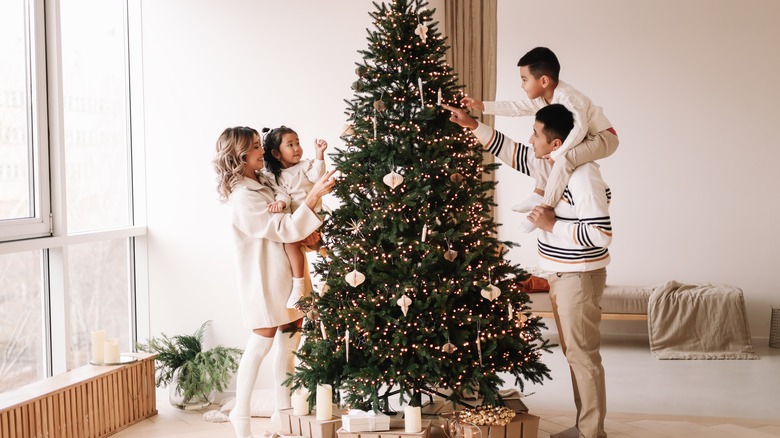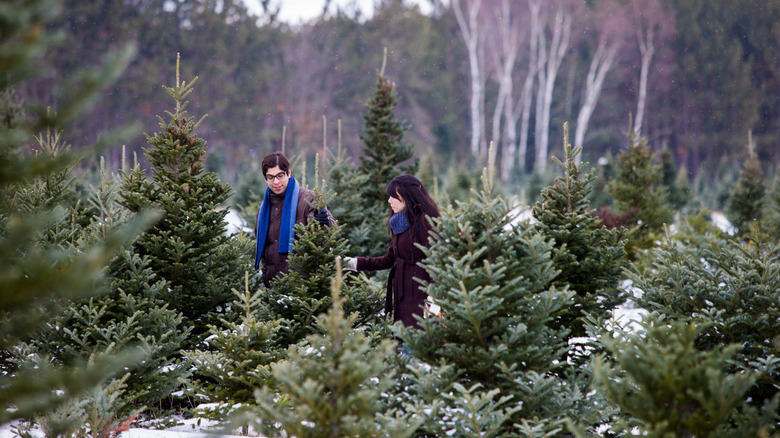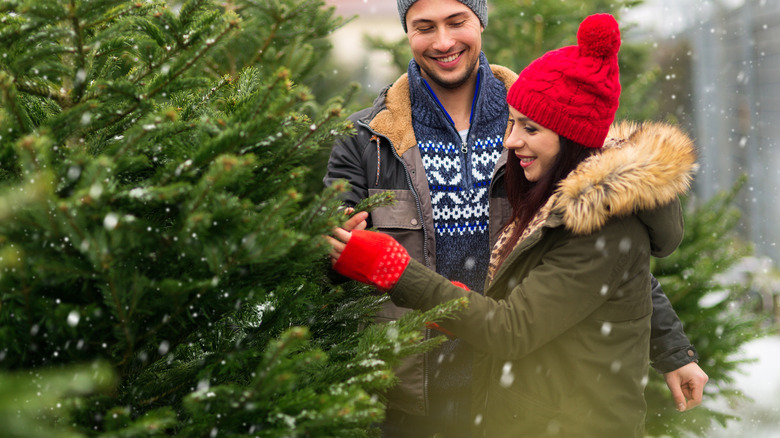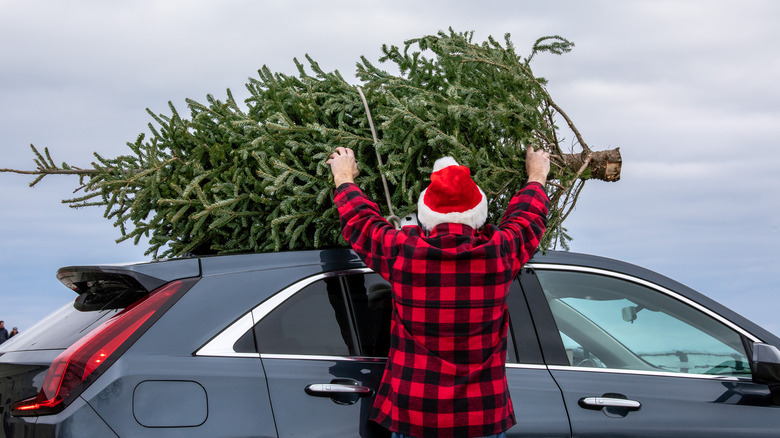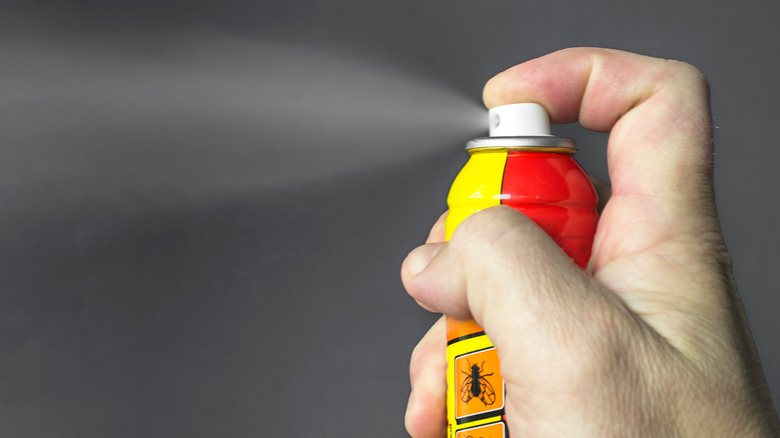Christmas Tree Bugs: 5 Tips For Keeping Your Home Pest-Free
Of course, Christmas time is the most wonderful time of the year! Whether you like receiving presents or snuggling against a cozy fire, there are many joys to this time of the year. However, what's not so great are the bugs that can lurk in your Christmas tree.
While it may not be the first thing that comes to mind, bugs can invade your home simply by being brought in with your freshly-picked tree: Critters, including mites, spiders, bark beetles, and more, can find their way into your house by way of Christmas trees (via Safer Brand). However, regardless of how these bugs enter your home, once they're in, it can be challenging to get them out. Fortunately, there are many ways to minimize this risk during the holiday season, so if you're a homeowner and want to keep your Christmas tree pest-free this year, we've got five great tips that can reduce the likelihood of insect infestation.
1. Examine the trunk
The trunk of a sapling can tell you a lot about its health. In fact, Front Range Arborists suggest you look at the trunk of your chosen Christmas tree and inspect it for holes or loose bark since these are two common signs that indicate it may be infested with bugs. Another symptom to keep an eye out for include cracks throughout the bark. You also want to watch out for actual bugs that may be lurking in the trunk.
Don't wait until you arrive home to examine your natural Christmas tree. Instead, examine its trunk at the store before purchasing it, loading it into your car, and taking it with you. While it may seem like an extra step that can be easily overlooked, doing so can prevent a pest problem that leads to monetary losses or emotional distress. If there are any signs of insects, consider moving on to another tree and repeating this step.
2. Shake the tree before you take it home
While inspecting the trunk can save you headaches down the road, you should know that there are many types of bugs that can hide in your Christmas tree's branches. This goes for both real and artificial trees. According to Aptive, the most common bugs in these seasonal saplings are aphids, mites, spiders, sawflies, praying mantids, and more. But unfortunately, artificial trees can also be a home for spiders and cockroaches.
Luckily, you can minimize the threat of these pests by giving your tree a good shake before bringing it into your home. Shaking it out can also remove pollen, dust, dead needles, and more (via NC State Extension), and because you're getting rid of these unpleasant and unwanted aspects, you enhance the look of your sapling as well. In addition, by eliminating dead leaves that may hide insects in the branches, you may also spot the bugs more easily. Getting rid of the pollen can even bring some relief to those with allergies. In any case, you don't want to be too rough with the tree; otherwise, you risk losing way too many needles.
3. Wait to bring the tree in
If you've ever bought or picked up second-hand furniture for free, you understand the importance of waiting to bring the item into your house. Doing so can help prevent hitchhiking bugs from turning your home into their permanent residence. In addition, Advanced Pest Control recommends you carefully place used furniture outside or in a garage until you can properly inspect it for bugs, treat it, and ensure it's free of pests. This works for Christmas trees as well since both items are wood-based.
Not only can insects be gross, but they can also be challenging and expensive to get rid of once they've infested your property. You can avoid infuriating and costly insect issues by keeping your Christmas tree outside or in the garage before you take it in to decorate it. You can also spray the sapling with water and let it dry in the yard before bringing it indoors. If you own an artificial tree, you can leave it in the garage for a few days before decorating time arrives.
4. Don't spray with insecticides
While insecticides can be great for managing pest problems indoors and outdoors, spraying your natural or artificial Christmas tree with these solutions is not a good idea. Many aerosol bug sprays are extremely flammable, and your holiday tree can easily catch on fire, with Henson Fuerst Attorneys reporting that many mixtures, including insect repellents, contain alcohol. As such, combining insecticides with your Christmas sapling's branches and warm holiday lights isn't recommended. Such unfortunate and easy-to-avoid incidences can lead to monetary losses, significant damages, injuries, and even death.
Of course, the best way to prevent this is to avoid spraying your tree with chemicals designed to get rid of bugs. The National Fire Protection Association (NFPA) recommends you select a healthy tree, water it daily, avoid using real candles as nearby décor, check and replace your lights if damaged, and turn off the tree lights when left unattended.
5. Control the room temperature
There's nothing like turning up the thermostat in your home and enjoying the holiday season. However, raising the heat can actually do more harm than good if bothersome pests hitched a ride into your house on your Christmas tree. This is because warm climates can cause insect bugs to hatch (via Aptive). As a result, you may have an even worse experience with these bugs than you ever imagined.
So, if you suspect you brought bugs into your house, consider lowering the thermostat until the situation is under control. According to the Government of Canada, managing the temperature is a great way to control pests since keeping areas cool can significantly decrease their reproduction. Furthermore, insects can cease to grow or reproduce, which can minimize the size of an infestation. While this method won't get rid of the bugs on your Christmas tree, it can impact the amount you see on your property.
